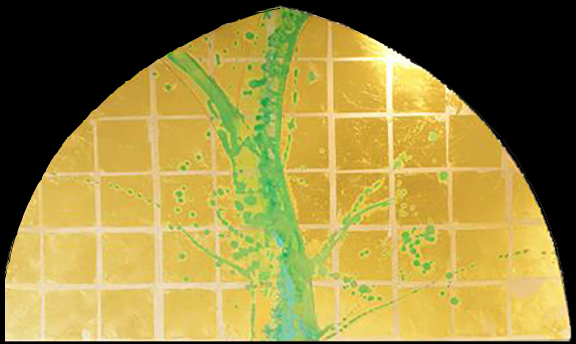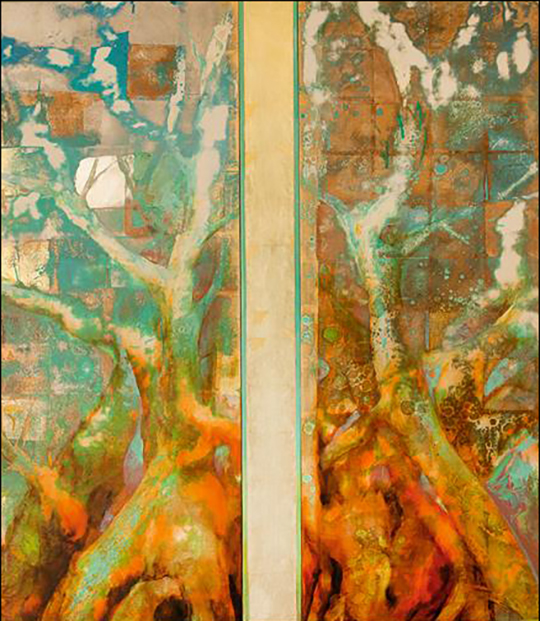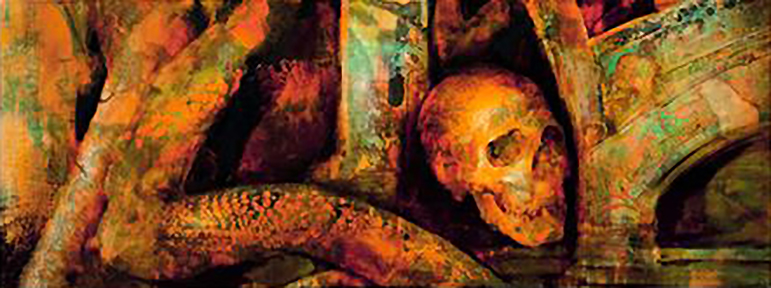April 1: The Risen Christ, Our Only Hope
♫ Music:
Day 48 - Monday, April 1
Title: THE RISEN CHRIST, OUR ONLY HOPE
Scriptures: 1 Corinthians 15:3-8,12-19, 32 (NKJV)
For I delivered to you first of all that which I also received: that Christ died for our sins according to the Scriptures, and that He was buried, and that He rose again the third day according to the Scriptures, and that He was seen by Cephas, then by the twelve. After that He was seen by over five hundred brethren at once, of whom the greater part remain to the present, but some have fallen asleep. After that He was seen by James, then by all the apostles. Then last of all He was seen by me also, as by one born out of due time. . . . Now if Christ is preached that He has been raised from the dead, how do some among you say that there is no resurrection of the dead? But if there is no resurrection of the dead, then Christ is not risen. And if Christ is not risen, then our preaching is empty and your faith is also empty. Yes, and we are found false witnesses of God, because we have testified of God that He raised up Christ, whom He did not raise up—if in fact the dead do not rise. For if the dead do not rise, then Christ is not risen. And if Christ is not risen, your faith is futile; you are still in your sins! Then also those who have fallen asleep in Christ have perished. If in this life only we have hope in Christ, we are of all men the most pitiable. . . .If the dead do not rise, “Let us eat and drink, for tomorrow we die!”
Poetry & Poet:
“Every Riven Thing”
by Christian Wiman
God goes, belonging to every riven thing he’s made
sing his being simply by being
the thing it is:
stone and tree and sky,
man who sees and sings and wonders why
God goes. Belonging, to every riven thing he’s made,
means a storm of peace.
Think of the atoms inside the stone.
Think of the man who sits alone
trying to will himself into a stillness where
God goes belonging. To every riven thing he’s made
there is given one shade
shaped exactly to the thing itself:
under the tree a darker tree;
under the man the only man to see
God goes belonging to every riven thing. He’s made
the things that bring him near,
made the mind that makes him go.
A part of what man knows,
apart from what man knows,
God goes belonging to every riven thing he’s made.
THE RISEN CHRIST, OUR ONLY HOPE
Today’s Scripture, art, and poetry invites us to explore the significance of Jesus Christ physically resurrected. Paul’s eloquent defense of the bodily resurrection of Christ in I Corinthians 15 is one of the most powerful passages in the New Testament. “If Christ is not risen, your faith is futile. . . . If in this life only we have hope in Christ, we are of all people most to be pitied.” Belief in the resurrection of Christ and at his return, the resurrection of all true believers is an essential doctrine of the faith. Our eternal deliverance from this decaying, adamic world with its mortality and corruptibility is a “blessed hope” that all Christians carry with them. As an ancient Christian hymn proclaims, “Christ is risen from the dead, trampling down death by death and upon those in the tombs bestowing life,” ceaseless, abundant life.
Prior to the Fall, Adam and Eve were naked and unashamed yet afterwards, our bodies became a personal source of shame–something hidden, private, changed, objectified. Out of this deprivation the heretical gnostic belief that the physical world is evil, or at best a means to an end, became popular. An extension of these lies is that the believer’s resurrection is ultimately only an idealized spiritual state in Heaven. Yet Paul writes in Romans 8:22 that the whole of creation groans, longing for Christ’s redemption. The physical creation is not meant to be permanently annihilated but fully resurrected as a brand-new creation in the dawning Kingdom of God. And it seems that in eternity we will have glorified bodies–bodies like Christ’s resurrected one (Job 19:26). I eagerly anticipate that our worn-out world will one day no longer be riven, but risen in the newness of God’s eternal realm.
Riven Tree, by artist Bruce Herman, depicts a theology of trees in Scripture advancing a compelling vision for humanity of the death and resurrection of Christ. Herman’s Riven Tree offers multiple meanings. His title shares the theme of riven-ness with the poem "Every Riven Thing'' by Christian Wiman. Riven means “split or torn apart” and both poem and image are imbued with wonder over God’s making and unmaking, brokenness and belonging, all amidst a world of mystery. Wiman’s poem states, “God goes belonging to every riven thing He has made.”
When Duke Divinity School commissioned Herman to do a resurrection painting, Bruce was struck by the challenge. Whereas typical resurrection paintings show an isolated, individual event often with Christ alone, Herman’s Riven Tree is a multi-layered, comprehensive narrative detailing the story of salvation. Like Paul’s resurrection apologetics, Herman’s painting becomes a visual defense of the Gospel. Here, there are thresholds that trace God’s story of redemption from ground zero (the predella) into the heavenly Kingdom of God (the lunette). Herman has constructed three main panels with five distinct sections that link the medieval elements of earth, water, fire, and air to the works of God and man.
The Roots of the Tree (the predella–bottom panel) shows the results of the Fall and Paradise lost. The skull symbolizes death as a consequence of man’s mistrust, pride, and disobedience as he returns to the earth. The serpent’s temptation, enticing Eve to eat from the tree forbidden by God, has led to a material world ruined by ambition and greed.
The Tree of the Cross (lower section of the central panel) suggests God’s intervention in human history, as we are “redeemed from fire by fire.” This section also references the Burning Bush which is never consumed but always aflame.
The Tree in Time (upper section of the central panel) hints at the Cross. Although troubled by toil and suffering, the emerging tree is seen throughout history, prophecy, and pilgrimage as a promise from God. This fruitful tree is a source of cleansing, poured out for us like healing rainwater that turns fallow ground into a fertile forest.
The Tree in Paradise Regained (the lunette–upper panel) reveals a tree that grows out of the Kingdom of God. “A shoot will spring from the stump of Jesse” (Isaiah 11:1). This panel symbolizes the fulfillment of time and time redeemed, with gold as the color of the new heavens and green for the new earth. The liberating airy feeling in the upper panel seems alive with the freedom Christ has won for us in his great victory over death.
Jesus Christ –The Tree of Life is depicted as a vertical shaft of gold (middle of the central panel), the ladder that bridges heaven and earth and restores humankind to God. Christ is the mysterious fifth element: the “ether” (the quintessence), in which all the elements are held together (Col. 1:17).
Today’s music, “The Green Man” by composer/poet Malcolm Guite, references a centuries old pagan legend that was redeemed and used by the Medieval church in Great Britain to reference Christ–the second Adam and True Vine. The chorus to “Green Man” ends, “If you cut me down, I’ll spring back green again.” The resurrected Green Man, Christ, can never be destroyed. One glorious new day, not soon enough yet not too far away, I too will be resurrected. My riven body, mind, heart, and soul will at last be what I like to think of as ‘shalomed.’ The messages in Herman’s painting and in Guite’s rollicking tune echo the ending of the creed Christians have been reciting for generations, “I look for the resurrection of the dead, and the life of the age to come.”
Prayer
We praise You, Father, Son and Holy Spirit for Jesus’ victory over our sin and death. Although we fail to fully understand the mystery of what’s to come, we trust Your goodness and love for our whole personhood. When the last trumpet sounds, we who are heirs and coheirs with Christ, will be raised incorruptible, and we will be changed. And perhaps we might shout out the ancient promise when it takes place: Death has been swallowed up in victory. Where, death, is your victory? Where, death, is your sting?
In Jesus Mighty Name we pray,
AMEN!
Alexandra Jean Davison, M.Div., M.Litt.
Director for Culture Care with
Artists in Christian Testimony International (A.C.T. Intl.)
Houston, Texas
https://www.actinternational.org/welcome
For more information about the artwork, music, and poetry selected for this day, we have provided resources under the “About” tab located next to the “Devotional” tab.
About the Art:
Riven Tree
Bruce Herman
2016
Triptych in oil and alkyd resin on wood panel
with 23-kt gold, platinum, and silver leaf
96 x 47 in.
York Chapel
Duke Divinity School
Durham, North Carolina
American artist Bruce Herman’s Riven Tree is a work that explores some of the rich theological meanings of the crucifixion of Christ. In many cultural traditions the tree is a central symbol—understood as life itself, sustenance of all living things. In Genesis 2, the human race was created from the dust of the ground, endowed with the breath of life, and freely given sustenance from the fruit of every tree in the garden, except one. Mistrusting the Creator, our forebears stole that forbidden fruit and fell from divine grace, and henceforth we were estranged from our Creator. In the Scriptures, the tree of the cross redeems us from our mortal fate. Jesus’ obedient death on the cross became the source of our redemption, freeing us from the entanglement of sin and death, opening once again access to the Tree of Life, and restoring our fellowship with our Creator.
About the Artist:
Bruce Herman (b. 1953) is an American artist, writer, curator, and educator. Herman lives with his best friend Meg. They’ve lived on the same street for thirty-five years and share their woodland home with their daughter Sarah, her husband Peter, and grandson Tristan—along with two dogs, two barn cats, a horse named Willow, and assorted wildlife. Herman is a painter, writer, and public speaker who taught studio art for forty years and recently retired from Gordon College, where he continues to curate exhibitions. His art has been shown in more than one hundred fifty exhibitions—nationally in a dozen US cities, including New York, Boston, Washington, Chicago, and Los Angeles, and internationally in Canada, Italy, England, Japan, Hong Kong, and Israel. Bruce’s artwork is featured in many public and private art collections including Hammer Museum, Los Angeles; Cincinnati Museum of Fine Arts; De Cordova Museum, Boston; Cape Ann Museum; the Vatican Museums in Rome; and in many colleges and universities throughout the US and Canada. His art and his words are widely published in books, journals, popular magazines, newspapers, and online art features. https://www.bruceherman.com/
About the Music:
“Green Man” (Single)
Lyrics:
My face in the foliage, you’ve seen that face before
It was carved in the Choir by your fathers back in the days of yore
I’m the power in the pulse I’m the song underneath the soil
I’m the unseen King of the ditches, ragged and royal
I’m the Green Man, don’t take my name in vain
I’m the Green Man, and it’s time to break my chain
If you cut me down I’ll spring back green again
I’m the roots on the stock I’m the tender shoots on the vine
I’m the goodness in the bread I’m the wildness in the wine
There’s power in the place where my smallest tendrils are curled
And my softest touch is the strongest thing in the world
I’m the Green Man, don’t take my name in vain
I’m the Green Man, I’m about to break my chain
If you cut me down I’ll spring back green again
I’m the grass at your feet and the leaves that shade your head
I’ll be the bower of love, I’ll be your green grass bed
I’m the finest flower, I’m the power in the wickedest weed
And I’ll plough your furrow with pleasure and plant my seed
I’m the Green Man, and I make love with the rain
I’m the Green Man, and I feel like breaking my chain
You might think I’m finished but I’ll spring up again
You can cover me in concrete, staple me down with steel
Spread your houses and your car parks over my fields
But I’ll still be there keeping everything alive
And I’ll spring back green but you may not survive
I’m the Green Man, don’t take my name in vain
I’m the Green Man, it’s time to break my chain
You can cut me down but I’ll spring back green again
About the Composer/Performer:
Malcolm Guite (b. 1957) is a poet, author, Anglican priest, teacher, and singer-songwriter based in Cambridge, England. He has published six collections of poetry: Saying the Names, The Magic Apple Tree, Sounding the Seasons: Poetry for the Christian Year, The Singing Bowl, Waiting on the Word, and the recently released Parable and Paradox: Sonnets on the Sayings of Jesus and Other Poems. Rowan Williams and Luci Shaw have both acclaimed his writing, and his Antiphons appeared in Penguin’s Best Spiritual Writing, 2013. Guite’s theological works include What Do Christians Believe? and Faith, Hope, and Poetry: Theology and the Poetic Imagination. Guite is a scholar of J. R. R. Tolkien, C. S. Lewis, and the British poets, and serves as the Bye-Fellow and chaplain at Girton College at the University of Cambridge, while supervising students in English and theology. He lectures widely in England and the USA, and in 2015 he was the CCCA Visionary-in-Residence at Biola University. Guite plays in the Cambridge rock band Mystery Train and his albums include The Green Man and Dancing Through the Fire.
https://malcolmguite.wordpress.com/
https://en.wikipedia.org/wiki/Malcolm_Guite
About the Poetry and Poet:
Christian Wiman (b. 1966) is an American author, editor, and translator of eleven books including, most recently, Joy: 100 Poems. He graduated from Washington and Lee University in Lexington, Virginia, and has taught at Northwestern University, Stanford University, and Lynchburg College. Currently, he teaches literature and religion at Yale Divinity School and the Yale Institute of Sacred Music. Wiman has written for The New Yorker, the New York Times Book Review, The Atlantic, and numerous other publications. He is a former Guggenheim Fellow. Wiman explores themes of spiritual faith and doubt in his sparse, precise poems. Praising Wiman’s “ear for silence” in a book review of Every Riven Thing for the Smartish Pace blog, John Poch observed, “Repeatedly in this collection, in his careful way, he presses his ear against the hive of belief. It takes a renewed childlike faith, and Wiman achieves it through memory and imagination and, one gets the feeling, grace.”
https://www.poetryfoundation.org/poets/christian-wiman
https://imagejournal.org/artist/christian-wiman/
About the Devotion Writer:
Alexandra Jean Davison, M.Div., M.Litt.
Director for Culture Care with
Artists in Christian Testimony International
(A.C.T. Intl.)
Houston, Texas
https://www.actinternational.org/welcome
Alexandra Jean Davison is the director for Culture Care, a ministry department of Artists in Christian Testimony International (A.C.T. Intl.). Her Culture Care blog and work equips churches to show Christ in hospitable explorations in faith, imagination, and artistry. She received an M.Div. in Apologetics at Southeastern Baptist Theological Seminary in North Carolina. She then went on to receive an M.Litt. in Theology, Imagination and the Arts at the University of Saint Andrews in Scotland. She lives in Houston, Texas, USA.
For more information, see www.culturecarerdu.com.



